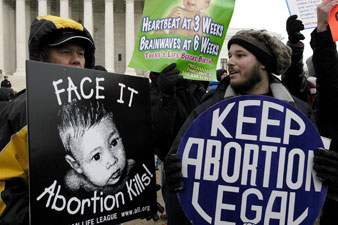 Reuters Photos
Reuters Photos
Protesters march on the anniversary of Roe v. Wade in 2005.
In the summer of 1993, a housewife from Grants Pass, Oregon, named Rachelle Ranae (Shelly) Shannon traveled to Wichita, Kansas, with a Bible and a .25-caliber pistol and shot George Tiller, a 51-year-old doctor and abortion provider. Tiller was not the first physician so targeted–six months earlier, an abortion provider named David Gunn had been murdered outside his medical clinic in Pensacola, Florida–but, despite sustaining wounds in both arms, Tiller managed to survive the attack. Sixteen years later, while standing in the foyer of his church, where he was serving as an usher and distributing bulletins, Tiller was shot again. This time he wasn’t so lucky.
The election of Barack Obama, it was said, would put the culture wars behind us, and two weeks ago, in a commencement address at the University of Notre Dame, President Obama tried to inject a note of civility into the debate about abortion. In his speech, Obama urged opponents and supporters of abortion rights to seek common ground by working to reduce the number of unintended pregnancies. He also told the story of an e-mail he’d received from a doctor who had voted for him in the Illinois primary but who’d taken offense at a passage on Obama’s website describing “right-wing ideologues who want to take away a woman’s right to choose.” The doctor characterized himself as prolife and wrote, “I do not ask at this point that you oppose abortion, only that you speak about this issue in fair-minded words.”
Obama wrote back to thank him and directed his staff to alter the wording, which, in its original form, was positively gracious compared to the language on www.stopobamanotredame.com, a website featuring the writings and video clips of Operation Rescue founder Randall Terry, who showed up at Notre Dame to protest and who compared Obama, unfavorably, to Herod. “Obama wants open ended child-killing,” declared Terry on the website, promising to “raze hell” in the “war” to come. After the murder of Dr. Tiller, Terry came forward with more inflammatory words, calling Tiller “a mass murderer” and adding, “Those men and women who slaughter the unborn are murderers according to the Law of God. We must continue to expose them.”
It is too early to say whether the murder of Dr. Tiller will trigger a wave of violent terrorism targeting abortion providers similar to the one that took place during the mid-1990s. It is not too early to be struck by the parallels. Then, as now, the violence came not in a moment of triumph for the prolife movement but in the face of isolation and defeat. The year Shelly Shannon shot Dr. Tiller was the year that Bill Clinton assumed office. It was the year after the Supreme Court ruled, in the Casey decision, that the central holding of Roe v. Wade “should be affirmed.” It was the year that a small band of militant antiabortion activists began openly endorsing murder and that a blueprint for violence and sabotage called the Army of God Manual declared, “All of the options have expired. Our Most Dread Sovereign Lord God requires that whosoever sheds man’s blood, by man shall his blood be shed.”
Popular
"swipe left below to view more authors"Swipe →
The Bush presidency brought John Roberts and Samuel Alito to the Supreme Court, but, for now, Roe remains the law of the land, and while opponents of abortion have managed to chip away at the right to choose in recent years, they have failed, even in states like South Dakota, to get the procedure banned by popular vote. For all the talk during the Bush years of the religious right’s cultural and political resurgence, a firm majority of Americans continues to believe abortion should remain legal under at least some circumstances. The true believers who had their hopes for dramatic change raised and then dashed by Bush are not likely to be feeling optimistic right now.
“Fair-minded words” are what Barack Obama called for at Notre Dame. Yet his election has brought coarsened rhetoric from the right on more than just the abortion front. Sonia Sotomayor, the Puerto Rican woman Obama recently nominated to the Supreme Court, has been denounced as a “racist” and compared to David Duke by the likes of Rush Limbaugh and Newt Gingrich. “Terrorist” and “Kill him!” were among the shouts heard at right-wing rallies during last year’s presidential campaign. Bullets kill. Inflammatory words merely incite. But those who deploy hateful language can hardly profess shock when their words are taken seriously, particularly over emotionally freighted issues that have sparked violence. Before he was murdered, George Tiller was a popular topic on Fox’s O’Reilly Factor, with the host referring to him as “Tiller the Baby Killer,” a man guilty of “Nazi stuff.” These are not innocent words, as doctors targeted by antiabortion protesters have pointed out in the past. In a letter to his hometown newspaper some years ago, one such physician wrote:
The members of the local non-violent, pro-life community may continue to picket my home. They may continue to scream that I am a murderer and a killer when I enter the clinics at which they ‘peacefully’ exercise their First Amendment Right of freedom of speech. They may do all of the above to me and other abortion providers of this community. But please don’t feign surprise, dismay and certainly not innocence when a more volatile and less restrained member of the group decides to react to their inflammatory rhetoric by shooting an abortion provider.
This letter appeared in The Buffalo News in 1994, one year after Shelly Shannon shot George Tiller. Its author, Barnett Slepian, a physician and abortion provider, was murdered four years later while standing in the kitchen of his home. He was the last abortion provider to be gunned down in America, until George Tiller was.


